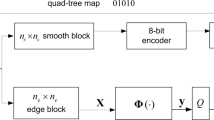Abstract
We propose in this paper a new method based on binary space partitions to simultaneously mesh and compress a depth map. The method divides the map adaptively into a mesh that has the form of a binary triangular tree (tritree). The nodes of the mesh are the sparse non-uniform samples of the depth map and are able to interpolate the other pixels with minimal error. We apply differential coding after that to represent the sparse disparities at the mesh nodes. We then use entropy coding to compress the encoded disparities. We finally benefit from the binary tree and compress the mesh via binary tree coding to condense its representation. The results we obtained on various depth images show that the proposed scheme leads to lower depth error rate at higher compression ratios when compared to standard compression techniques like JPEG 2000. Moreover, using our method, a depth map is represented with a compressed adaptive mesh that can be directly applied to render the 3D scene.
Access this chapter
Tax calculation will be finalised at checkout
Purchases are for personal use only
Preview
Unable to display preview. Download preview PDF.
Similar content being viewed by others
References
Scharstein, D., Szeliski, R.: A taxonomy and evaluation of dense two-frame stereo correspondence algorithms. Int. J. Computer Vision 47(1), 7–42 (2002)
Krishnamurthy, R., Chai, B., Tao, H., Sethuraman, S.: Compression and transmission of depth maps for image-based rendering. In: IEEE Conf. Image Processing (October 2001)
Chai, B., Sethuraman, S., Sawhney, H., Hatrack, P.: Depth map compression for real-time view-based rendering. Pattern Recognition L 25(7), 755–766 (2004)
Morvan, Y., de With, H.N., Farin, D.: Depth-image representation employing meshes for intermediate-view rendering and coding. In: SPIE Conf. Electronic Imaging: Stereoscopic Displays and Applications (January 2006)
Sarkis, M., Diepold, K.: Content adaptive mesh representation of images using binary space partitions. IEEE T. Image Processing 18(5), 1069–1079 (2009)
Farin, D., Peerlings, R., de With, H.N.: Depth-image representation employing meshes for intermediate-view rendering and coding. In: 3DTV Conf. (May 2007)
Kim, S.Y., Ho, Y.S.: Mesh-based depth coding for 3D video using hierarchical decomposition of depth maps. In: IEEE Conf. Image Processing (October 2007)
Bao, P., Gourlay, D., Li, Y.: Context based depth image compression for distributed virtual environment. In: IEEE Conf. Cyberworlds (December 2003)
Sappa, A.D., Garcia, M.A.: Coarse-to-fine approximation of range images with bounded error adaptive triangular meshes. SPIE J. Electronic Imaging 16(2) (April 2007)
Lindstrom, P., Koller, D., Ribarsky, W., Hodges, L., Faust, N., Turner, G.: Real-time, continuous level detail rendering of height fields. In: ACM SIGGRAPH, August 1996, pp. 109–118 (1996)
Wang, Y., Lee, O.: Use of two-dimensional deformable mesh structures for video coding, part II–the analysis problem and a region-based coder employing an active mesh representation. IEEE T. Circuits and Systems for Video Technology 6(6), 647–659 (1996)
Pajarola, R.: Overview of quadtree-based terrain triangulation and visualization. Technical Report UCI-ICS-02-01, Information and Computer Science, Uni. California Irvine (2002)
Demaret, L., Dyn, N., Iske, A.: Image compression by linear splines over adaptive triangulations. Signal Processing J. 86(7), 1604–1616 (2006)
Yang, Y., Wernick, M.N., Brankov, J.G.: A fast approach for accurate content-adaptive mesh generation. IEEE T. Image Processing 12(8), 866–880 (2003)
Scharstein, D., Pal, C.: Learning conditional random fields for stereo. In: IEEE Conf. Computer Vision and Pattern Recognition (June 2007)
Cormen, T.H., Leiserson, C.E., Rivest, R.L., Stein, C.: Introduction to Algorithms, 2nd edn. The MIT Press, Cambridge (2001)
Said, A.: Introduction to arithmetic coding theory and practice. Technical Report HPL-2004-76, Hewlett-Packard Laboratories (2004)
Said, A.: Comparative analysis of arithmetic coding computational complexity. In: Data Compression Conf. (March 2004)
De Jonge, W., Tanenbaum, A., Van De Riet, R.: Two access methods using compact binary trees. IEEE T. Software Engineering SE-13(7), 799–810 (1987)
Shishibori, M., Mochizuki, H., Arita, T., Aoe, J.I.: An efficient method of compressing binary tries. In: IEEE Conf. Systems, Man, and Cybernetics (October 1996)
Scharstein, D., Szeliski, R.: High-accuracy stereo depth maps using structured light. In: IEEE Conf. Computer Vision and Pattern Recognition (June 2003)
Zitnick, C., Kang, S., Uyttendaele, M., Winder, S., Szeliski, R.: High-quality video view interpolation using a layered representation. ACM T. Graphics 23(3), 600–608 (2004)
Author information
Authors and Affiliations
Editor information
Editors and Affiliations
Rights and permissions
Copyright information
© 2010 Springer-Verlag Berlin Heidelberg
About this paper
Cite this paper
Sarkis, M., Zia, W., Diepold, K. (2010). Fast Depth Map Compression and Meshing with Compressed Tritree. In: Zha, H., Taniguchi, Ri., Maybank, S. (eds) Computer Vision – ACCV 2009. ACCV 2009. Lecture Notes in Computer Science, vol 5995. Springer, Berlin, Heidelberg. https://doi.org/10.1007/978-3-642-12304-7_5
Download citation
DOI: https://doi.org/10.1007/978-3-642-12304-7_5
Publisher Name: Springer, Berlin, Heidelberg
Print ISBN: 978-3-642-12303-0
Online ISBN: 978-3-642-12304-7
eBook Packages: Computer ScienceComputer Science (R0)




